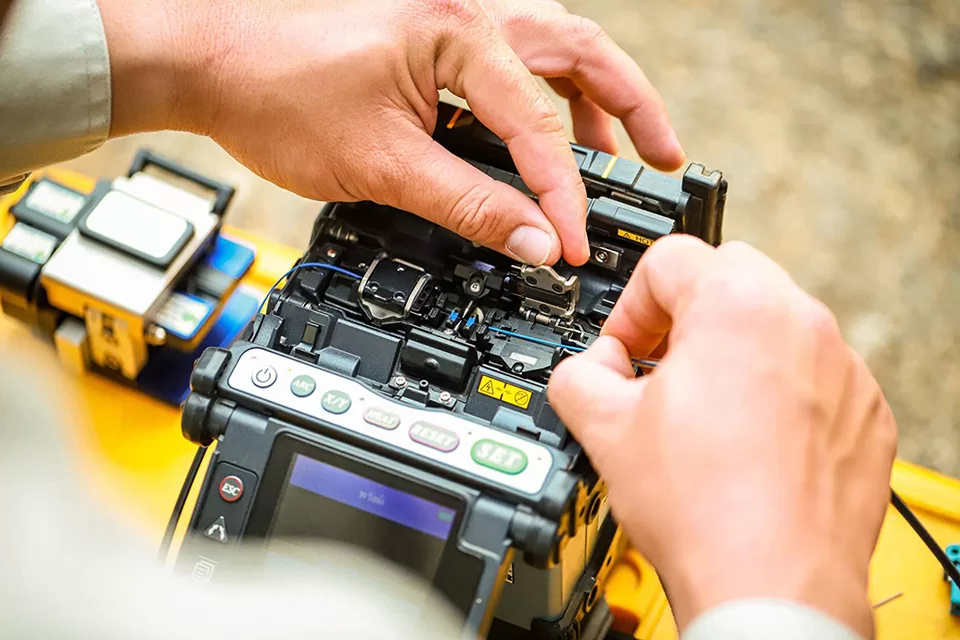
A emenda de fibra óptica é o processo de unir dois cabos de fibra óptica para criar um caminho contínuo para transmissão de dados. É um processo crítico na instalação e manutenção de redes de fibra óptica.
Tipos de emenda de fibra óptica
Emenda mecânica
A emenda mecânica é um processo relativamente simples que envolve o uso de uma ferramenta especial para alinhar e manter os dois cabos de fibra óptica juntos. É uma boa opção para reparos rápidos e fáceis, mas não resulta em uma conexão tão forte quanto a emenda por fusão.
Emenda de fusão
A emenda por fusão é um processo mais complexo que envolve o uso de um arco elétrico para fundir os dois cabos de fibra óptica. Isso resulta em uma conexão muito forte e permanente. A emenda por fusão é o método preferido para unir cabos de fibra óptica em redes de alto desempenho.
Benefícios da emenda de fibra óptica
- Ele permite a criação de cabos de fibra óptica mais longos.
- Permite a conexão de diferentes tipos de cabos de fibra óptica, como cabos monomodo e multimodo.
- Permite a reparação de cabos de fibra óptica danificados.
- Ele pode ser usado para criar personalizado conjuntos de cabos de fibra óptica.
Aplicações de emenda de fibra óptica
- Redes de telecomunicações
- Redes de data centers
- Redes locais (LANs)
- Redes de longa distância (WANs)
- Sistemas de controle industrial
- Aplicações militares e aeroespaciais
Processo de emenda
O processo de emenda pode ser dividido nas seguintes etapas:
- Preparação: Os cabos de fibra óptica são preparados removendo a capa externa e o revestimento tampão das extremidades dos cabos. Os núcleos de fibra óptica são então limpos para remover qualquer poeira ou detritos.
- Alinhamento: Os núcleos de fibra óptica são alinhados usando uma ferramenta especial chamada cutelo. O cutelo cria um corte preciso e perpendicular na extremidade de cada núcleo de fibra óptica.
- Emenda: Os núcleos de fibra óptica são unidos usando emenda mecânica ou emenda por fusão.
- Teste: A emenda é testada para garantir que seja forte e que a transmissão de luz seja boa.
Equipamento de emenda
O seguinte equipamento é normalmente usado para emenda:
- Cutelo de fibra óptica
- Decapador de fibra óptica
- Decapador de buffer de fibra óptica
- Limpador de núcleo de fibra óptica
- Splicer de fibra óptica
- Refletômetro óptico no domínio do tempo (OTDR)
Melhores Práticas
Ao emendar cabos de fibra óptica, é importante seguir as seguintes práticas recomendadas:
- Use ferramentas limpas e calibradas.
- Certifique-se de que os núcleos de fibra óptica estejam devidamente alinhados antes da emenda.
- Use o método de emenda apropriado para a aplicação.
- Teste a emenda para garantir que ela seja forte e que a transmissão de luz seja boa.
Informações adicionais
Fechamento de emenda de fibra óptica é um tipo de equipamento de fibra óptica usado para fornecer espaço de armazenamento e proteção para cabos ópticos emendados. FiberCheap é um fornecedor líder de fechos de emenda de fibra óptica na China, solicite orçamento grátis agora.
